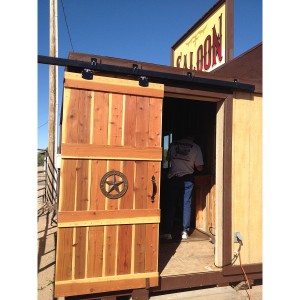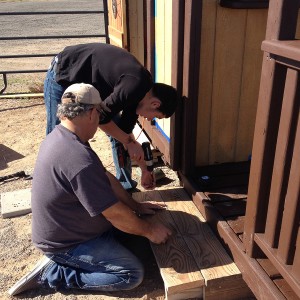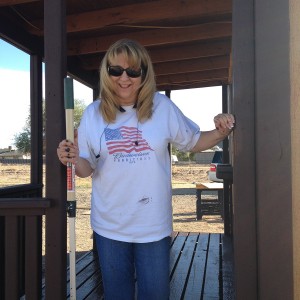
by Lara Serbin | Apr 7, 2015 | Architectural Planning, Architecture, Blog, Collaboration, Graphics, Interiors, Planning
By: Lara Serbin, Buckeye Main Street Coalition
Last month was the National Main Streets Conference in Atlanta, Georgia. The Buckeye Main Street Coalition members Jay Broadbent, Charlene Powers, Brian and Kristi McAchran and Lara Serbin were fortunate to attend this important event. We had many opportunities to talk to others who are doing similar events, facade improvements and fundraising. We wanted a different perspective on how to improve historic downtown Buckeye. March 30 through April 1st was packed with learning sessions at the Omni Hotel. Below are some of the sessions offered:
The Museum on Main Street: The Smithsonian Comes to Town
A Rule Breakers Guide to Accessible, Sustainable and Economical Brick Streetscapes
Understanding Today’s Sponsors, Matching their expectations to your needs
People Power: Engaging Your Community Members
Activating Space with Community Partnerships
Defining value in down town festivals and events
Crowdfunding for Public Spaces and Community Places
Mobile Workshops explored downtown districts located in and around Atlanta. City staff, City Managers, Main Street volunteers and business owners took us on walking tours and explained lessons learned regarding revitalization. There are so many lessons and creative ideas that came out of these tours. Meeting other Main Street members was a significant way to affirm or re-examine how we do things. We went to Atlanta to make our downtown Buckeye better.
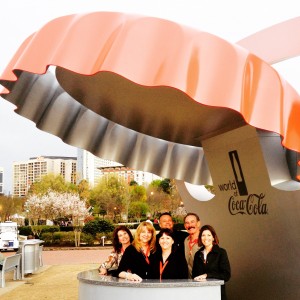
Buckeye Main Street Coalition at Coca Cola
Atlanta: Historic Downtown Tour
This tour was led by Paul Hammock, Director of Education at the Atlanta Preservation Center. He took us to Five Points, Grant Park and Martin Luther King National Monument. He pointed out the wall of mega buildings dividing circulation. Many historic buildings have been demolished. As with any well developed urban core there have been preservation losses and few wins. He took us to a 1950’s parking structure where the Victorian Kimball House Hotel the most beautiful hotel in Atlanta used to stand.
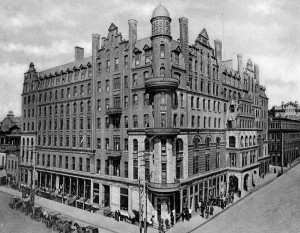
Kimball House Hotel Atlanta
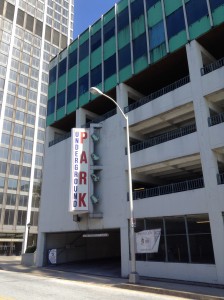
1950’s Parking Structure replaced Kimball House
The biggest win for the city of Atlanta is the Fox Theatre saved by the wrecking ball by the local citizens. A 1928 lavish theater house with Egyptian and Moorish style interior, halls for dining and outdoor roof decks.
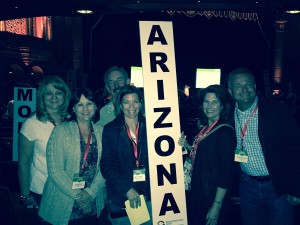
Opening Ceremony Atlanta
The Opening Plenary Session took place at the Fox Theatre and Buckeye Main Street Coalition held the Arizona sign proudly! The most memorable stop was Grant Park, a mile south of downtown. The Atlanta Preservation Center purchased Atlanta’s most significant and endangered house in Atlanta, the antebellum Lemuel P. Grant Mansion. Back in the day this house was king of the hill with acres of cotton. Now the single story is shoe horned among historic homes. Inside the spaces there are artifacts like stair stringers propped up against the exposed thick walls resembling rammed earth walls of the southwest. Before Atlanta Preservation bought this place it looked like a Roman ruin with no roof and nature taking over. This building restoration gives gave me great hope for the Buckeye Historic Courthouse and Jail that is in such need of stabilization.
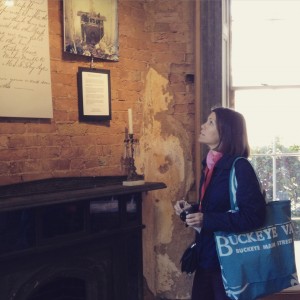
Lara Serbin at Atlanta Preservation Center
The original wood panel flank the tall window openings. The last stop in the city core was the Martin Luther King National Monument Landmark. Several city blocks are reserved for a museum, crypt, visitor center and the Ebenezer Baptist Church.
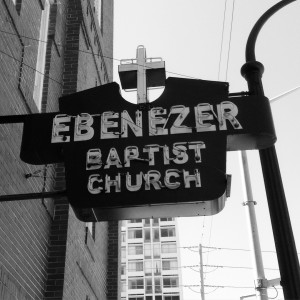
Martin Luther King National Monument
I sat in the church pew and listened to Dr. King to rest from taking photos. The space had a simple interior and intricate stained glass. It was a sacred space well cared for.
Tactical Urbanism: 10 Ways to Restore Your Downtown for $500 or Less
In between the mobile tours there were educational workshops. A huge drop cloth, stack of wood pallets and tools told me this was a hands-on 3 hour course. There were 10 different Tactical Urbanism projects happening simultaneously.
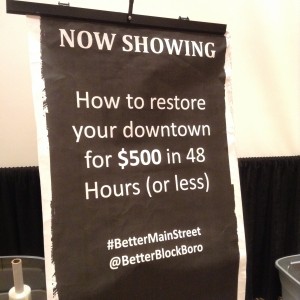
Tactical Urbanism Work Session
Volunteers were asked to build things like a flower display and adirondack chair from wood pallets. Even though a lot of it was staged like a cooking show on Food Network, it held my attention. While volunteers were constructing, cutting and bolting the mediator was fielding questions like how to not get in trouble with the highway department after tagging bicycle symbols on downtown streets.
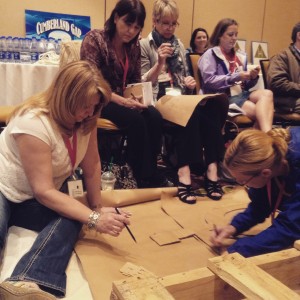
Charlene Powers and Cheryl Sedig at Tactical Urbanism Work Session
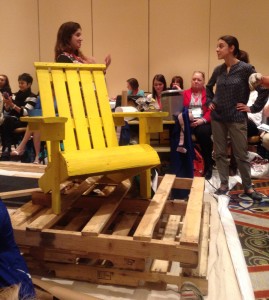
Making an adirondack chair out of wood pallets
Maybe that is how most of us want to learn now, with chaos. At the end of 3 hours the teams had constructed a “Parklet”, chairs set on top of a raised platform with movie screen backdrop. I think most folks on Main Street organizations are finding ways to get their projects completed lighter, quicker and cheaper. I walked away with ideas on how to make future workshops in downtown Buckeye more interactive and fun.
Monroe: Creating a Downtown Destination through Local Investors Tour
The road that leads to Monroe is flanked with grand mansions of the cotton era. Monroe has its dark stories of segregated mass lynching in 1946 and current poverty, but they acknowledge their past honestly and embrace agrarian roots with pride. The historic downtown is vibrant with stores like Buckles Hardware, Little Italy’s Peppino’s Pizzaria and Rinse Bath & Body.
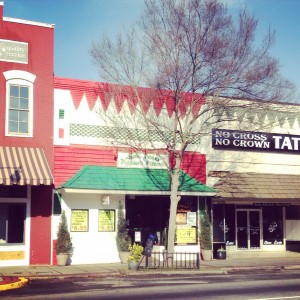
Monroe, GA historic downtown
City officials, Main Street volunteers and buildings owners were there to greet us at The Wayfarer Music Hall a community space to lease. Lemonade, ginger cookies, vase of flowers and goodie bags made me realize the impact of hospitality. The owner of the building was there, she was a Monroe native and had rehabilitated the 1910 building into a vital community event center in the historic corridor. The first floor she leases out for events like rehearsal wedding dinners. A second entrance opens to a flight of narrow wood stairs leading to The Wayfarer Hotel.
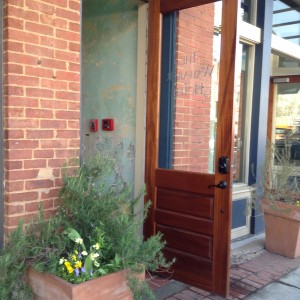
The Wayfarer Hotel
The Hotel is self sufficient without check in or full time staff. The walls have exposed brick and original plaster. Even the coffee bar is a shared space.
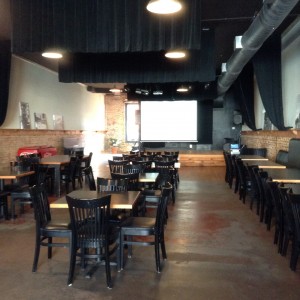
The Wayfarer Music Hall
She kept the improvements to the interior simple by only carving out what was necessary like a 3 compartment sink, hand wash station, ADA restroom and lockbox. Made me think of Buckeye and how we could so use a space like this to host events. It is a sign of the times to create a space that has an open ended use.
Keep Marching On with Faith, Hope and Love. Dr. Martin Luther King
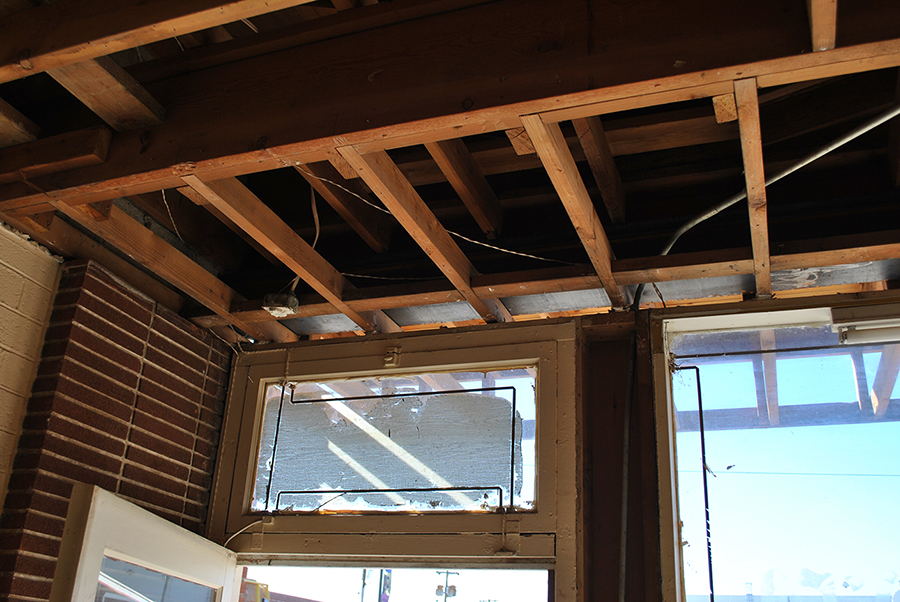
by Jeff Serbin | Mar 20, 2015 | Architectural Planning, Architecture, Blog, Collaboration, Interiors, Planning, Uncategorized
You are either looking or just leased a space or own an existing building and have a few changes you want to make. The first step is to hire a design professional who can make your project successful. Whether it’s relocating a few interior walls, a complete renovation to the facade, a major improvement to a space for a new cafe or office, an update to a Network Operation Center, the architectural design team can determine the scope of the project and meet your needs while satisfying the current building codes. They will also coordinate with contractors to ensure budgets are met or give you a reality check on the current dollars to improve.
PROGRAM DEVELOPMENT
The first stage of design before any pencil is put to paper is a well established ‘Architectural program’. This can come in many forms depending on the complexity of the project.
Architectural Program – “Defines the required functions of a project. It should include estimated square footage for each use all elements to achieve the project goal.”
I recently was talking with a well educated Real Estate broker who had a client that was uncertain whether he wanted open office cubicles or private offices within his suite. He wanted to analyze the benefits of open office vs. private office or a mix there of but wasn’t sure where to start. The agent didn’t realize that part of the architects role is to master plan the space as well as pick out the finishes. As part of the programming, MASTER PLANNING can open and eventually determine what is best suited for your company.
If it’s a first timer who is not familiar with design process, the architect may have a little more work on their hands. A well established business may have their needs clearly defined already. The planning and efficiency of an office can be equated to dollars. As we know in a home, a well functioning kitchen using the triangular work station design is very efficient. This idea is no different in an office. Every project is unique, every client has expectations, business technologies are always improving and design philosophies change over time. Mixing all these ingredients isn’t as easy as following the back of a Kraft Macaroni and Cheese Box.
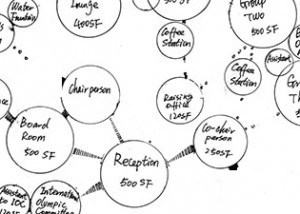
Programming Bubble Diagram
EXISTING VERIFICATION
Most of the time, there is little to no existing drawings to work from. Even if we are handed what looks like a complete set of drawings, relying on them can lead to a major mistake later down the road. I have experienced first hand structural elements that show up on drawings which were not existing in the field. The prior contractor must have made a change in the field and didn’t update the drawings. Therefore, verifying as much of the space possible is important. In many cases, structures and building systems are covered by architectural finishes and therefore there are unknowns unless exploratory demolition is possible.
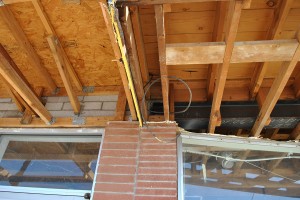
Existing condition uncovered on Tenant Improvement. An existing steel beam was uncovered where we thought masonry occurred.
DESIGN
Whether it’s relocating a few walls or adding a few lights to a building, the design team needs to complete their ‘due diligence’. The design team needs to ensure the existing building systems are up to current codes and in good working order. You cannot assume or expect the prior tenant or building owner did everything correctly. Sometimes we run across items that were built without permits. And remember, codes do change over time. Therefore, bringing in a complete design team of architect and engineers is important.
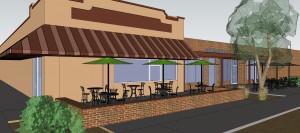
Tenant improvement Facade Remodel
SIMPLIFYING A PROJECT
Another thing that we run into is that some client simplify the project. One may think moving a few walls is fairly straight forward however these changes can affect many building systems and in essence open up the can of worms. For example it can affect lay in ceiling grids, lighting fixtures, electrical outlets, mechanical duct work, fire sprinklers, fire alarm systems etc. This list can be extensive.
Even the simple aspect of remodeling or adding a restroom to an existing suite can have complications. With current ADA codes and changes to MPE systems, laying out a restroom can also have a domino effect and a good design team is needed to make this change simple. We also run into the mentality sometimes that ‘This is how we have done it in the past’. Maybe codes and methods have changed.
CONSTRUCTION DOCUMENTATION
Once the design direction is established, the architect should at this time ensure what the City of jurisdiction may require. Every City has interpretations of the codes and each reviewer read those in grey. Once the drawings are completed and coordinated among the various engineers, the drawings are ready to be submitted for building permits.
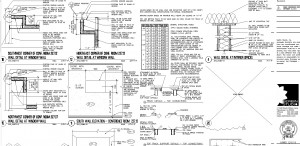
CONSTRUCTION
The architect’s role does not stop at the issuance of a permit. Once the contractor is underway, especially on a tenant improvement, questions come up that should be answered by the design team. As you saw above in the photo, we sometime finds surprises such as that unknown steel beam. The design team in that scenario had to come up with alternative detailing to address that specific condition. Therefore sometimes decisions are made on the fly once systems are uncovered and layers of old design are peeled away. All changes should be documented so everyone is on the same page.
Ultimately, the design team is the eyes of the client to ensure the contractor is following the design that was developed. The bottom line is that we strive for a positive outcome and “We Make You Look Good!”
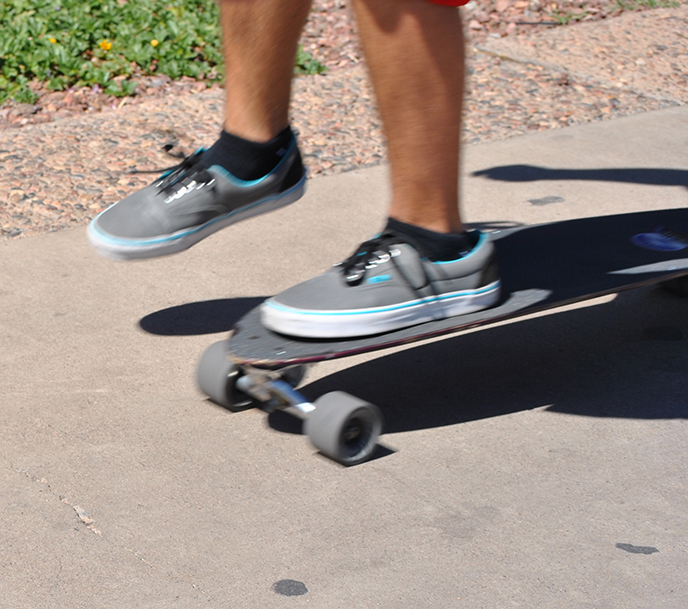
by Jeff Serbin | Feb 26, 2015 | Architectural Planning, Architecture, Blog, Collaboration, Graphics, Interiors, Planning, Uncategorized
“A small effort made towards completion of a much larger task”
What about Bob? (1991) Comedy staring Bill Murray. (Movie Clip)
Dave Ramsey’s – “Baby steps into financial freedom”. I need some of this.
UrbanDictionary.com “To make progress on something in small increments”
ONE GIANT LEAP FOR MANKIND
All around us, we see giants like Apple announcing $1.7 Billion in European projects or closer to home in Arizona $2 Billion over 10 years on a Data Center in Mesa. Tesla is building a battery plant costing upwards of $4 Billion. I have to admit that I do salivate over working on a project for a client like Apple. Apple, you can call me anytime you want.
The $2 Billion dollar data center is said to have ~150 employees once in operation with many people driving by without any clue really what goes on inside. They are important facilities and do bring large amounts of revenue, but the impact on our immediate daily activities are directly minimal. I suppose they do help our computers and phones search quicker, but just like turning on a light bulb, most of us don’t fully understand how the electricity comes from power station to that bulb.
I have worked on projects costing many millions of $ with large multi-billion dollar companies, so I know the drill. The projects within these large facilities have a factor of speed and complexity which is very exciting. Some are hush hush while others are news worthy. But working on small projects has its complexities and gratification as well. ITS LIKE PLANTING A SEED.
The large projects are like giants taking large steps, but what about those small projects which feel immaterial.
Those small projects are for some, BABY STEPS. They can influence and have huge impacts upon its users and people who pass on by.
THAT’S ONE SMALL STEP FOR A MAN
In a smaller city, building projects may not take up an entire city block or involve Billions of dollars to complete, but those projects have a big impact because metaphorically, that ocean is much smaller and the fish appear only bigger.
Working on historical downtown revitalization projects feel like BABY STEPS. For example, adding a dozen or so trees to a main street in Buckeye feels insignificant to many, but just wait until those trees mature and provide shade and beauty to downtown. We have just planted a seed.
We have just planted another seed in Buckeye, the improvement to the facade at the Carniceria Taqueria or the landscape courtyard improvements at Millstone Cafe in Downtown Buckeye. Yes these are small moves in the overall scheme of things, but think of the influences it will have on other business owners to update their properties after they see the success it has brought. The seeds are only beginning to sprout.
Sometimes we all need to take BABY STEPS to get the momentum flowing in the right direction.
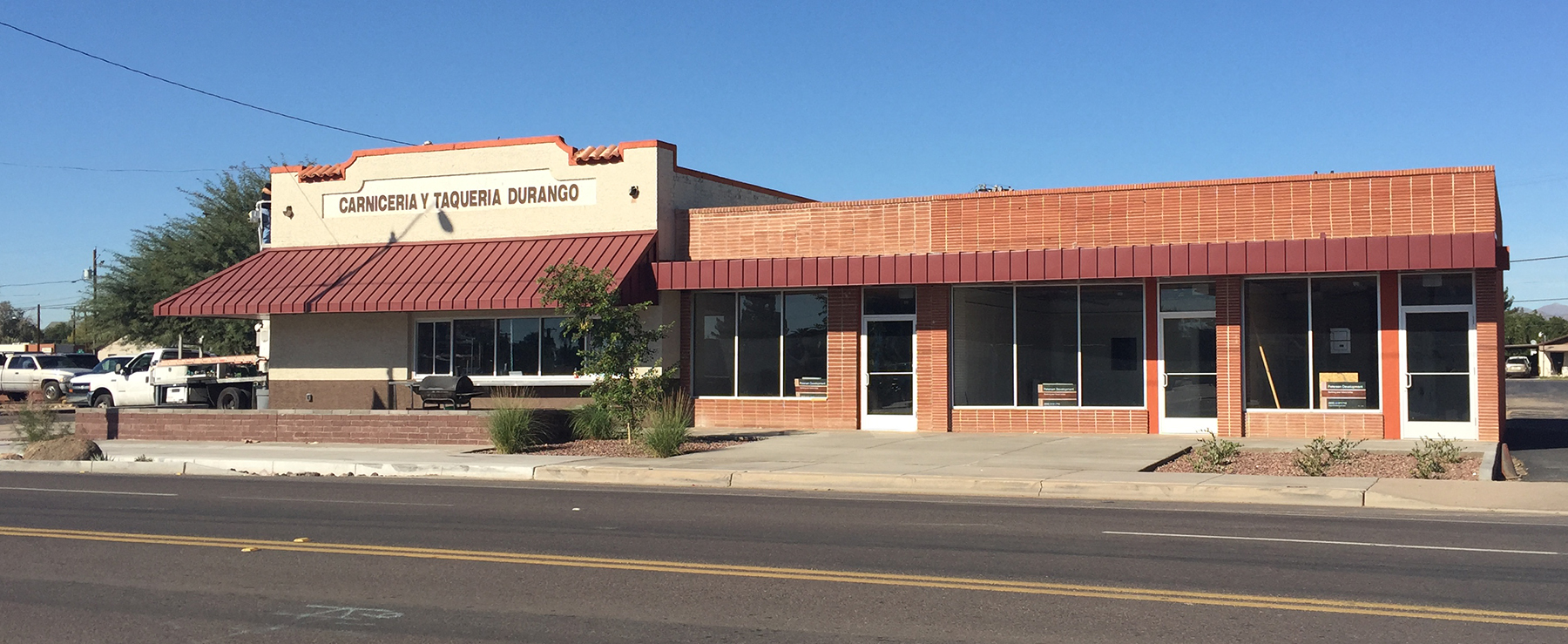
by Jeff Serbin | Feb 24, 2015 | Architectural Planning, Architecture, Blog, Collaboration, Commercial Architecture, Graphics, Interiors, Planning, Uncategorized
On January 1, 2014 the Town of Buckeye in Western Maricopa County became a City. Over a year has come and gone and becoming a City is a big responsibility and the residences in Buckeye are stepping up to the challenge. Late last year, the City of Buckeye provided a Grant (catalyst) to assist business owners to improve its cache of buildings to attract more business.
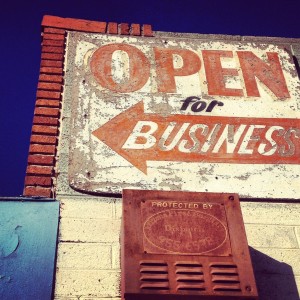
Buckeye is open for business
We are seeing allot of excitement coming in the near future from the recently awarded projects. We are all Chomping at the bit just like first settlers who must have watched with excitement as the waters flowed down the Buckeye Canal system in 1907.

Buckeye canal
Serbin Studio’s involvement on the Buckeye Main Street Coalition, we take pride of assisting business owners in many ways. Whether it’s educating others how important it is for your business presence to communicate to the public, whether its your web presence or physical storefront, we have been working on our design muscles.
Downtown Buckeye along Monroe has a collection of historic buildings (OK they aren’t actually on the historic register), but they do have history. Buckeye wants to preserve and improve upon what stock we have. Just like a cowboy trying to stay on the horse a little bit longer, we are all working on improving how we do things.

Buckeye Rodeo
The Carniceria Y Taqueraa Durango resides in one building in the heart of downtown Buckeye. Located a stones throw from City Hall and Buckeye Valley Chamber, a portion of it currently sits vacant. It is begging for some TLC to inspire others to occupy and utilize it. Late December 2014, a design was proposed by Serbin Studio to the City of Buckeye Council and was approved.
Serbin Studio is currently developing the design and providing the necessary details so it is a successful build.
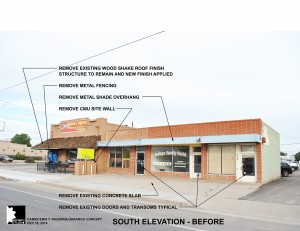
Carniceria before
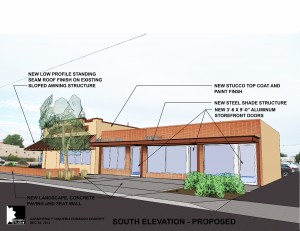
Carniceria after
As Mayor Meck states, Buckeye is truly open for business.
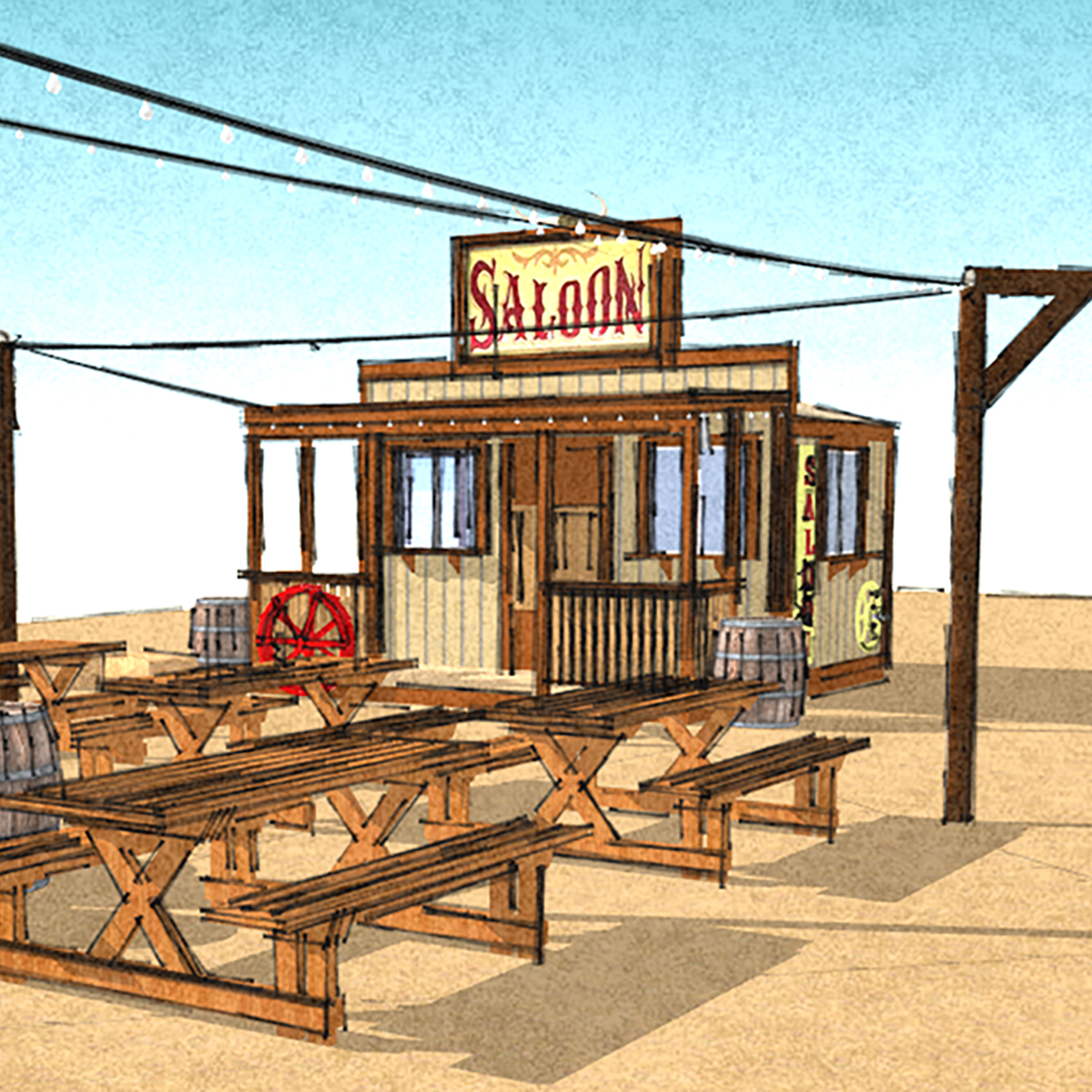
by Jeff Serbin | Nov 18, 2014 | Architectural Planning, Architecture, Blog, Collaboration, Graphics, Interiors, Planning, Uncategorized
Demolition derby is once again upon us in Buckeye, Arizona. The event is this Saturday Nov 22 at 7 pm. This event has been part of Buckeye for over the past 20+ years. As the contestants are getting their vehicles ready to mash them up and put another notch in their fan belt, members of the Buckeye Rotary and Buckeye Main Street Coalition were prettying up the beer both that resides at the Helzapoppin Rodeo Arena.
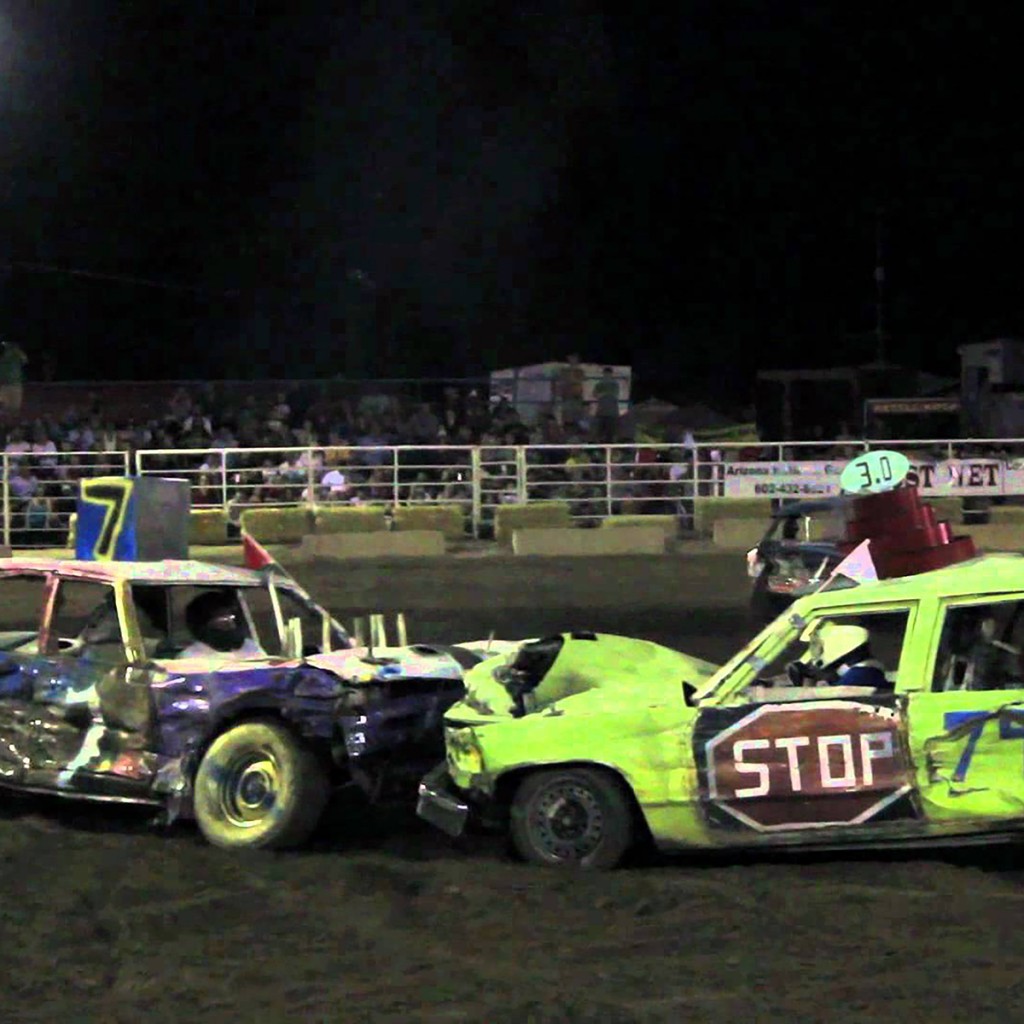
Besides sitting in the sun and painting a beer booth (The ironic thing is I don’t even drink beer) for an entire day reminiscing about Ralph Macchio in the Karate Kid, what did I gain from this experience?
Community involvement is definetely a fun and awarding way to work along people in your community. Usually work meetings come and go and topics are mainly business and politics, but sharing the day with others while working on something collectively that improves your City makes you even more proud of where you live. What other City can you go to an event and Mayor Meck calls you by name.
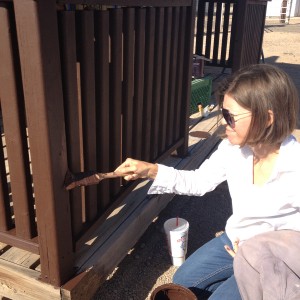
Lara Serbin painting the pickets
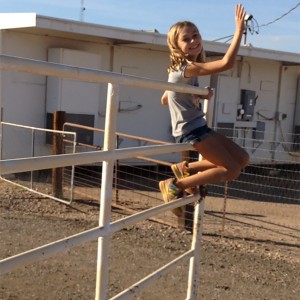
Lily Serbin Taking a break to have some fun!
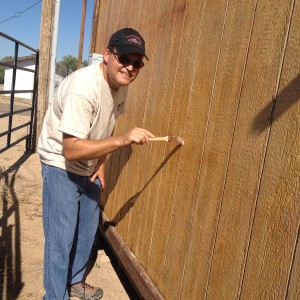
Jeff Serbin getting a bit too detailed
The beer booth, an attraction for the demolition derby, known for raising College scholarship funds by the Buckeye Rotary Club by selling beer, looked like it had gone through its own derby and was in need of some TLC. Years of weathered siding was re-branded like a cow.
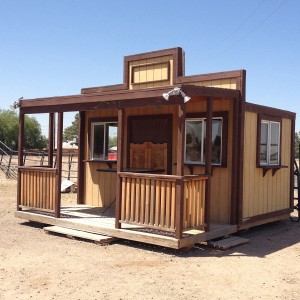
Beer booth before
Did you know, the rodeo is coming back to the Helzapoppin’ Arena in January 2015 so get your irons out. We don’t want any stray cows running through downtown Buckeye, except for the Parade organized by the Buckeye Main Street Coalition on Monroe Avenue that occurs during that afternoon.
Through months of planning, working closely with the Buckye Rotary, we came up with some enhancements to make the Saloon a bit more attractive. With a reality check of budget and constructability issues, we begin our fury of work this weekend.
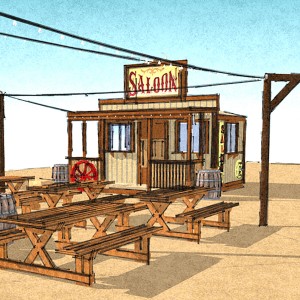
Beer Booth concept, now the “Saloon”
One thing we learned was that 7 gallons of paint can be your best friend, if slowly applied and well brushed. Some of us tackled the inside with new lighting and power and others tackled the outside. Thanks to a local artist, Ron Clarke, the beer booth was re-branded as a “Saloon”.
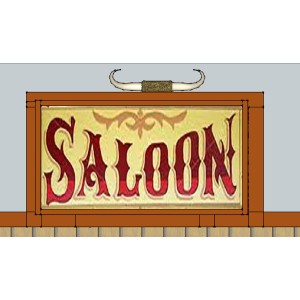
Saloon. Anyone have some horns we can mount on top? Let Lara know.
Over time we will be adding further elements to make this unique to Buckeye, Arizona. Now all of you will know where to go before and after the derby to say hello to all the Buckeye Rotarian’s serving up some nice cold ones.
After attending the event, it was an eye opener to see all that attended and to witness the activity around the Saloon. It just goes to show that clear signage is important to people know what you may be doing, which in this case was selling beer. All proceeds from this Rotary event go to a B.U.H.S. Scholarship fund. That is Buckeye Union High School Folks.
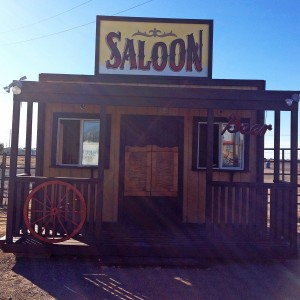
Beer booth After
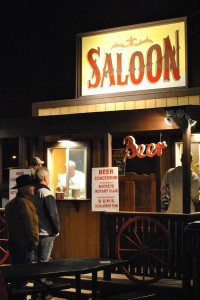
Night of the Demolition Derby November 22, 2014
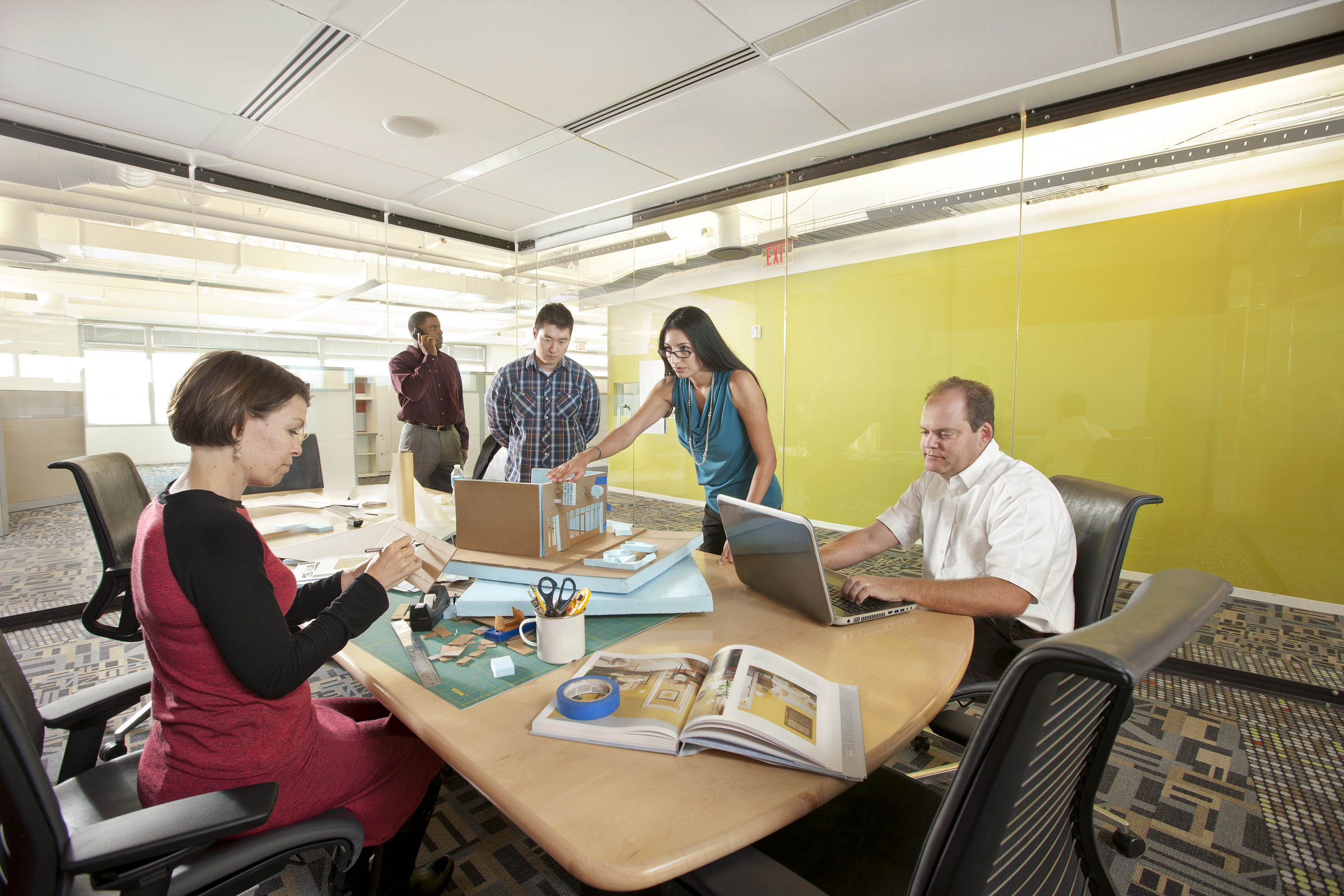
by Jeff Serbin | Oct 16, 2014 | Architectural Planning, Architecture, Blog, Collaboration, Planning, Uncategorized
Design and construction is a lengthy process not understood by many. From my experience, the typical client wants to occupy a space faster than what is feasible. I am a realist when it comes to project schedules and typically that may not be what the client wants to hear who has an un-realistic goal. I prefer to …
This industry has many moving parts, puzzles to be solved and involves multiple people; the target ‘time’ is sometimes hard to pin down. Let me describe a typical process from 10,000 feet level.
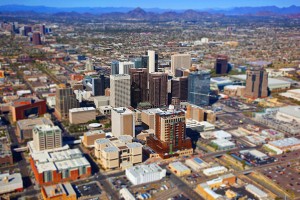
Aerial of what City?
1) CLIENT CALLS THE ARCHITECT
No two clients, no two projects, no two buildings and no two sites are alike.
(I have had a repeat client within a repeat building with repeat city inspectors using a repeat contractor. But this is not common). Determination of time to complete a project varies.
2) ARCHITECT GATHERS A TEAM
Mechanical, Plumbing, Electrical, Structural, Civil, Interiors etc. Projects vary in building type and scale. Project schedules can be dictated by teams availability. Engineers vary in expertise. The team must be appropriate for the project. Gathering a team takes time.
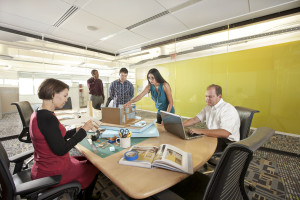
Serbin Studio’s Current Office
3) EXISTING VS. NEW BUILDING
No two properties are alike. With an existing building, architects must understand what the existing conditions are and what information is available (original drawings?). Every city is unique in building codes and inspectors. When we submit drawings to the city for permitting, it is out of our control how much time is needed for a city permit review process.
4) PROPOSAL TIME
Typically with smaller and less sophisticated clients, they inquire about fees. A client is buying a service influenced by many factors, not buying a product. Teams have to be gathered based upon scope. Proposals require thought to ensure the architect has covered all services. This process takes time and it is impossible to give a quote over the phone.
5) DESIGN TIME – Let us look at a typical process at 10,000 ft level.
Phase 1 – Schematic Design
Architects are like Nancy Drew (Lara) and Shirlock Home (Jeff) to uncover all the facts. This would include time to gather information from the client, understand in-direct influences from the surrounding context, City and code constraints, the list goes on and on. The information gathered transforms into a schematic design. Good time for a cost estimate.
Phase 2 – Design Development
Once a schematic design is chosen, further development of the project includes definition of systems (structural, mechanical, electrical etc.) and building materials.
Phase 3 – Construction Documentation
Once the building systems and materials are chosen, the architect and engineers put together documents that are used for permitting and final pricing by the contractor. An architect can assist in the recommendation of a contractor. The process should take a few weeks to complete dependent on the size of the project.
Phase 4 – Construction
During construction, questions arise and the architect should be consulted. We can be your eyes to uncover un-warranted changes made by the contractor. It is common for people be stuck in their ways and build things how they have done in the past. The architect and engineer are conscious about every line, note and drawing that is on that set. A contractor should ask to deviate from the plan, not beg for mercy after the fact.
I make every attempt to follow through on promises and prefer to follow the moto ‘UNDER PROMISE, OVER DELIVER’. However the most important element is communication. No matter what field you are in, if a deadline is fast approaching and you feel that you may not be able to keep that promise, letting your client know is the best approach.



























